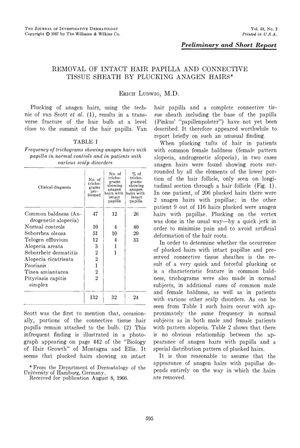Removal of Intact Hair Papilla and Connective Tissue Sheath by Plucking Anagen Hairs
June 1967
in “
Journal of Investigative Dermatology
”

TLDR Plucking hairs in a certain way can result in intact hair roots, not related to baldness.
In a study from 1967, researchers investigated the removal of intact hair papilla and connective tissue sheath by plucking anagen hairs. They found that when plucking anagen hairs, a transverse fracture of the hair bulb occurs near the summit of the hair papilla. Occasionally, portions of the connective tissue hair papilla remained attached to the bulb. This was considered an infrequent finding. The study involved plucking tufts of hair from patients with common female baldness (androgenetic alopecia), resulting in two cases where anagen hairs showed roots surrounded by all elements of the lower portion of the hair follicle. In one patient, 2 out of 206 plucked hairs had papillae, and in another, 9 out of 116 hairs had papillae. The occurrence of plucked hairs with intact papillae and preserved connective tissue sheaths was also observed in normal subjects and patients with various scalp disorders, suggesting that the appearance of anagen hairs with papillae depends entirely on the method of hair removal. The study concluded that the way hairs are plucked is the determining factor for the appearance of anagen hairs with intact papillae, rather than it being a characteristic feature of common baldness.

